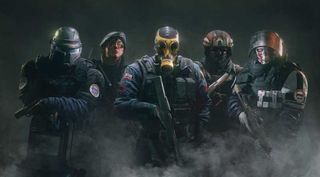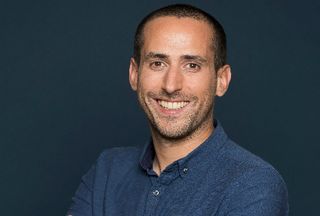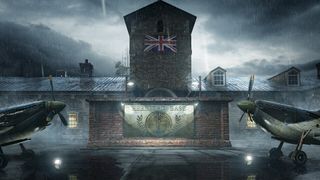Ubisoft on Rainbow Six Siege's first Major tournament and its booming esports scene
The past, present and future of Siege esports as told by François-Xavier Deniele.

After a series of hotly-contested season finals during its opening year, Rainbow Six Siege hosted its first Invitational in early 2017. With events spanning Montreal, São Paulo, Atlantic City, Katowice and beyond, the online shooter held its inaugural Major in Paris last month.
Over two years since its debut campaign, the modern Siege esports scene is near unrecognisable—and it shows little signs of slowing down. With this in mind, I caught up with Ubisoft esports director François-Xavier Deniele at the Paris Major to discuss the past, present and future of Siege's ever-growing competitive spectrum.

François-Xavier Deniele joined Ubisoft in 2009 as a brand manager. Having held a handful of senior managerial positions since, he became the company's director of esports in February of last year.
PC Gamer: The Paris Major is Siege's first ever Major. It seems like the Siege esports scene is in rude health.
François-Xavier Deniele: Yes, it really is. For me and my esports department at Ubisoft, our first Major is a great achievement. We've brought it back home, to Paris, and the reason for doing that was not only because this is Ubisoft, but also because we wanted to reward the French community. They've been here from the beginning. There are four teams in the pro league, there are two at the Major.
It was the right time to say: guys, we're going back.
You can hear the crowd cheering behind us. They get particularly loud for the French teams.
Oh, absolutely. That said, the crowd at São Paulo were just as loud. An amazing crowd.
The biggest gaming news, reviews and hardware deals
Keep up to date with the most important stories and the best deals, as picked by the PC Gamer team.
Siege has grown so much since launch that it's become almost unrecognisable. Can the same be said about its esports scene?
It can. I mean, it's hard to say that we could've predicted being here three years ago. But even before the release of the game, before the rest of the world had played it, we knew we had something different from the competition. For example, what Counter-Strike is doing is great, it's really good, but we wanted to propose something different.
When the production came back with the idea of: okay, we will create the perfect field between a shooter and a MOBA, and take the best argument for both; it was then: okay, let's take the Rainbow Six brand and see where we can take it. It was really good to mix all of these ingredients together.
What we can see today, as you mentioned, it's not the same game almost three years on. The teams are so close to each other now that we have a really good standard. It's so exciting.
Where do you think the new operators, Clash and Maverick, fit into the pro side of Siege?
That's a good question because every new season we ask the same thing. Players need to change their capacity and strategy—depending on whether they're playing as the new operatives or playing against them. Before we release the new characters, we have some workshops with the pro players to make sure we get the balance right. Then we run alphas and beta for the community. Not everyone plays at the same standard as the pro players. Getting the balance is important.
This mix of players is essentially pushing the production team, too. The workshops let players see all the elements before the release and we can gather feedback.
Where we are truly different from other games is our focus on multiplayer. It wasn't an easy decision at first. But it was, I think, the right decision.
François-Xavier Deniele
From your perspective, is Siege's esports scene a different entity from the base game or are they interlinked across the board?
They are absolutely interlinked, completely. The esports scene is feeding the game all the time, by the pro players and by the dedicated community that follow.
At the same time, however, the game also affects the rules and functionality of the esports scene. I work everyday with Alexandre Remy and it's crucial that we work together as a team to make both worlds work. If he has an issue with the production, we need to feed each. It'd be a huge mistake for us to pursue different agendas because our game constantly reflects what the community wants.
The esports community is also really vocal, and occasionally their feedback isn't as positive as we want or hope it could be. But, because our game is for everyone, that's when it can be tricky. Ultimately, though, our community trusts us and we trust them.

Earlier this year, Siege introduced a familiar MOBA feature—Pick and Bans. How is that working out in the pro scene?
For me, there are two things. The first thing is that it was a complete change of strategy from the team and it was hard for some of us to understand at first. It was: okay, I now need to rework my strategy completely because I don't know which characters might be banned, I don't know which strategies I can push and put in place before the match. Understanding and appreciating that [process] was hard, but it's also part of our process for entertaining people—which is also important.
Now, with the new format of our esports competitions, every phase is so important. From the first Pick and Ban to the last shot at the last second, you can understand that, okay, the player made this particular decision because that operator was banned, or that decision because they were made to pick this operator. It's easier to follow.
What our team and the production team are working on is the creation of tools to help people better understand each phase. What is unique to Rainbow Six Siege is that there are different approaches to every phase of the game. Ultimately, everyone must be able to understand every phase of the game.
Siege chose multiplayer over singleplayer at launch. Is there ever any regret or desire to pursue the latter, given how big the Siege community now is?
It's always a question of balance. For the production team, it was a case of: okay, if we want to create a true competitive esports title, we need to focus on the multiplayer aspects. If you are creating operators and putting them into singleplayer—it's not the same rules, you can't do it.
Even from co-op to multiplayer, it's not the same rules there either. Where we are truly different from other games, it's the multiplayer. It's as simple as that. It wasn't an easy decision. It was a hard decision. But it was, I think, the right decision. We focussed all the production, all the planning on these elements. It was all or nothing. I think it's worked out okay.

You've now held your first Major. The Siege esports scene is constantly growing. What's next?
Our next immediate step is our Rio De Janeiro final in Brazil. This will be our first ever tournament that takes place within a stadium. Three years ago, this was a dream, and in November it's going to happen. For me, the main strategy for the next coming year is developing what we call the semi-professional and non-professional tournament—meaning if we want to become a top, top esports scene, we need to develop every level.
From the pros—which we showcase in things like the Paris Major—to the bottom, which is, for me, the grassroots, the local tournaments. This is the key to helping people understand the path to professional play. What do you have to do to become the average player? It's our job to show you.
Is that achievable? Can the average player join in at the bottom and end up at a professional Major?
For me, I think it's a great time to do so. If you watch for too long it might become too difficult to become a world champion, but our national championship has really come a long way. There are so many players, but we plan to open more and more non-professional tournaments. You can watch out for that.
Most Popular


